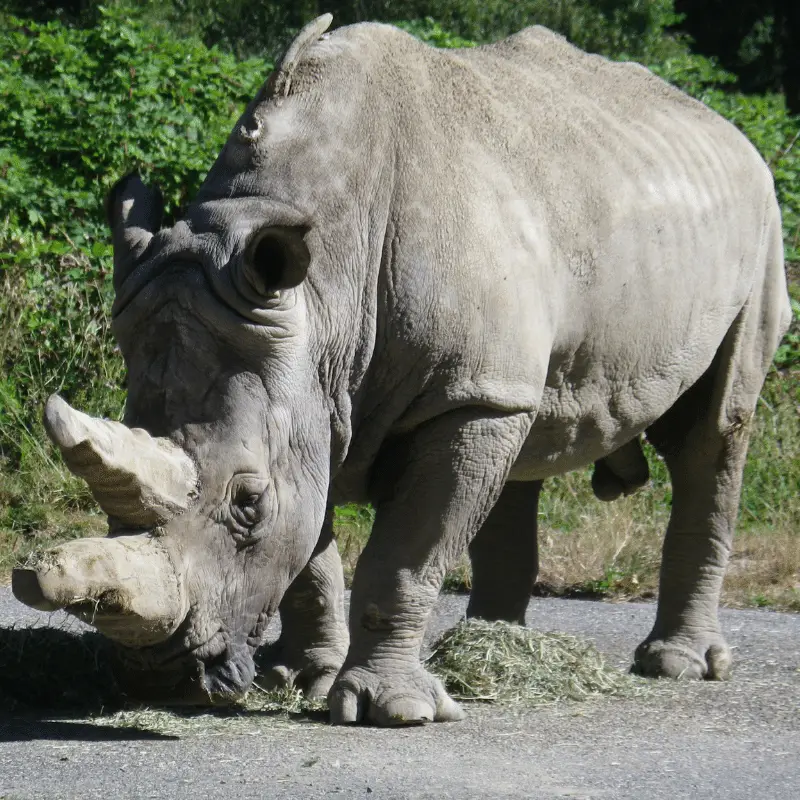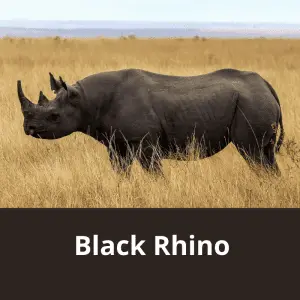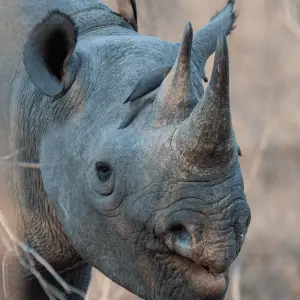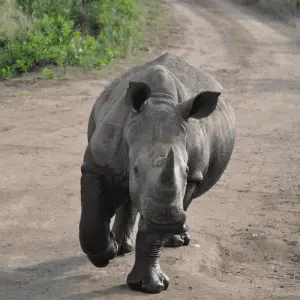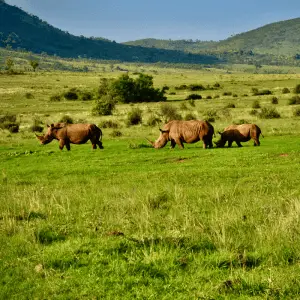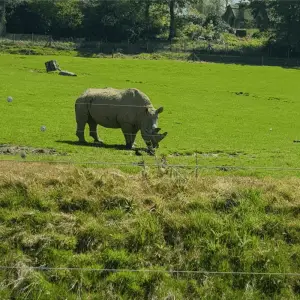The lifespan of a rhino is different depending on its species. The black rhinoceros lives for about 35 to 50 years, the Asian rhino lives for 30 to 40 years. White rhinos live for up to 40 to 50 years. However, they don’t always make it that long in the wild due to predators, poaching or hunting.
What Affects The Age Of A Rhino
The rhinoceros is one of the world’s most endangered animals. The reasons below will affect the age of a rhino they will reach. Their lives will be sadly cut short.
Predators
Rhinoceroses have a strong hide that protects them from most of the predators living in the wild. Not only that, as these animals are one of the largest land mammals, but most of the predators also do not dare to attack fully grown adult rhinoceros.
A strong adult rhino doesn’t have any animal predators. However, when they get old, rhinos tend to get a little weaker, giving an option for risk-taking attacks from big cats, crocodiles, African wild dogs and hyenas.
The only predator that threatens the rhinoceros is humans.
Recommended Read: Why Do Rhinos Charge?
Baby rhinos are also vulnerable to attacks from big cats, crocodiles, African wild dogs and hyenas. Although most of the time, the mother rhino will protect them and fight away any threats.
Mother rhinos are extremely hostile when having the responsibility of looking after their young.
Recommended Read: Rhino Mothers And Pregnancy
Poaching
Sadly, some people want rhino horns. So they kill the rhinos and take their horns. The horn of a rhino can grow back like hair and nails. However, illegal poachers will kill from a distance first, enabling them to get closer to remove the horn.
Countries That Have a Desire For Rhino Horns
In certain Asian countries, rhinoceros horn is used for making traditional medicine. Some countries like Vietnam and China believe that medicines made with rhinoceros horns can cure almost every illness, including cancer. This misconception has created a massive market for rhinoceros horns in certain parts of Asia.
Internation Ban
Even though the international ban on the trading of rhinoceros horns has been able to curb some rampant dealings, the illegal market is still going strong. This rising demand in the illicit market fuels the poaching industry of rhinoceros horns.
Did you know some Rhino conservation camps have been safely removing the horns of a rhino to stop the poachers from doing it themselves? This way, the rhino lives and poachers don’t get the horns.
Do all rhinos have horns?
Yes, all five species of rhinoceros have horns. However, the length and size of the rhinoceros horn mainly depend on the species and gender of the animal.
| Rhino Species | Amount |
|---|---|
| Black Rhino (Female) | Two Horns |
| Black Rhino (Male) | Two Horns |
| Jarvan Rhino (Female) | One Horn |
| Jarvan Rhino (Male) | One Horn |
| Sumatran Rhino (Female) | Two Horns |
| Sumatran Rhino (Male) | Two Horns |
| The Greater One-Horned Rhino (Female) | One Horn |
| The Greater One-Horned Rhino (Male) | One Horn |
| White Rhino (Female) | Two Horns |
| White Rhino (Male) | Two Horns |
Hunting
Sadly, many humans desire to kill an animal for sport, even though it doesn’t happen as often nowadays. In the past, many trophy hunters would hunt a rhino.
How did the rhinoceros get their name?
The name of these gigantic animals has come from their exquisite horns that grow from their snouts. Rhino means nose, and ceros means horns. Together, rhinoceros indicates an animal that comes with long horns on their snout region.
Five Hundred Thousand Rhinoceroses – Once Upon A Time!
It is estimated that only 29,000 rhinoceroses are living in the wild. This number was once at five hundred thousand at the beginning of the 20th century. That’s roughly ten rhinos being killed every single day over 121 years. By these figures, you can understand how drastically the number of these rhinos have been reduced.
Extinct Rhino Species
In 2018, the last surviving male rhinoceros of the Northern white subspecies died due to natural causes. With this death of the rhinoceros, the northern white subspecies of the animals have functionally become extinct.
Even though two female Northern white rhinoceros live in captivity, they cannot breed as there are no living male rhinoceros available either in the wild or in captivity.
Countries Doing Well By The Rhinos Making Them Live Longer
Countries like India, Nepal, and certain countries of Africa have been working exceptionally well to protect and manage their rhinoceros population. That is why the rhinoceros species, like the greater one-horned rhinoceros, have been brought back from the brink of extinction.
Still, some species, like the Sumatran and the Javan rhinoceros, are highly vulnerable. Less than 60 Javan rhinoceroses live in a single national park of Java, Indonesia.
Rhinos Are Very Fast (Can Run From Threats)
Even though rhinoceroses are one of the largest land mammals ruling on earth, they are not slow on their feet. When necessary, a rhinoceros can run up to 30 km per hour. Not only that, while running, the rhinoceros are not at all clumsy. Instead, they are very light on their feet and easily avoid branches and trees in the thick forest area. While charging towards or away from something, rhinoceros can quickly turn and change their direction.
Fighting Between Rhinos
Whenever people see an image of rhinoceros, the first thing that comes into their mind is that their horn is a menacing weapon. While this assumption is not entirely false, not all the rhinoceros species use their horns for fighting or threatening other rhinos.
Certain rhinoceros species use their teeth while fighting with other rhinos or defending themselves from animal attacks. For example, the Sumatra and Javan rhinos use their lower incisor teeth to inflict wounds on their opponent.
Sumatra and Javan rhinos mostly used their horns for digging the ground and searching for edible roots. When it comes to the greater one-horned rhinoceros species, you can see them use their horns for both purposes.
That means these rhinos sometimes use their horns for fighting, while most of the time, they use their horns for digging holes and searching for food. Sometimes these rhinoceros also used their horns for posturing.
Compared to that, African rhinoceroses do not have long incisors, which they can use for fighting. Both the black and white African rhinoceros use their horns as their primary weapons.
Keeping Their Horns Sharp
Rhinos will rub their horns on uneven surfaces to make them sharp. By doing this, they prepare themselves to inflict maximum damage while attacking.
Eyesight Makes The Rhino Vulnerable To Attacks Thus Cutting Their Lives Short
Rhinoceroses are not blind; however, they do not have perfect eyesight. The potential reason for the poor vision is that they didn’t need to see far into the distance. The rhino had many other strong points, such as tough skin, size, and fast to suit their environment.
When rhinos evolved, they evolved to suit their surroundings to avoid and help them against any threats. Humans did not poach rhinos at this time and maybe never came into much contact with them.
However, having a better vision would improve their survival rate, especially if they could see potential threats like poachers before they saw them.
Were rhinos walking earth before humans?
No, humans have been walking the earth the longest, around 5 – 7 million years ago and rhinos around 1 million years ago.

